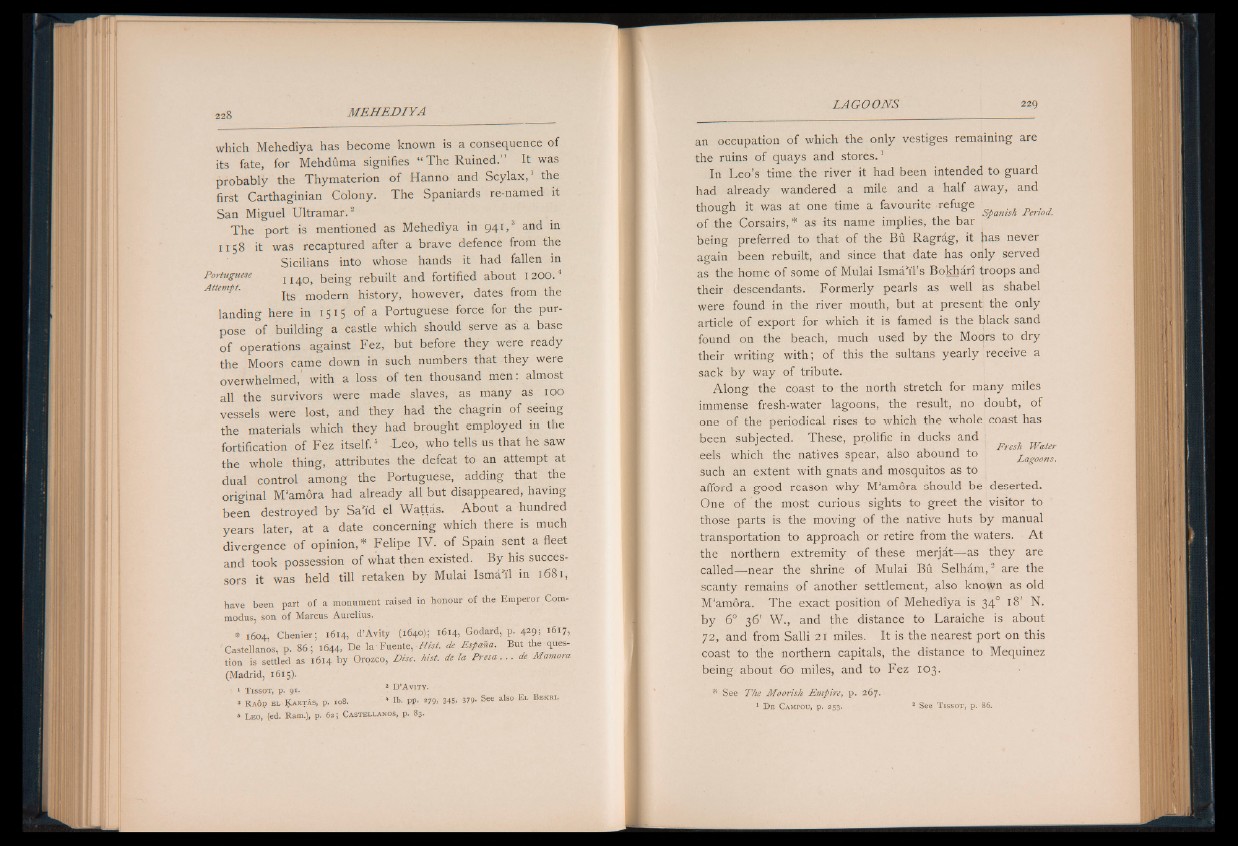
which Mehediya has become known is a consequence of
its fate, for Mehduma signifies “ The Ruined.” It was
probably the Thymaterion of Hanno and S c y la x ,1 the
first Carthaginian Colony. The Spaniards re-named it
San Miguel Ultramar.2
The port is mentioned as Mehediya in 9 4 1/ and in
1158 it was recaptured after a brave defence from the
Sicilians into whose hands it had fallen in
Portuguese j I 4 0 ) being rebuilt and fortified about 1200.4
Attempt. Jts mocjern history, however, dates from the
landing here in 1515 of a Portuguese force for the purpose
of building a castle which should serve as' a base
o f operations against Fez, but before they were ready
the Moors came down in such numbers that they were
overwhelmed,' with a loss of ten thousand men: almost
all the survivors were made slaves, as many as 100
vessels were lost, and they had the chagrin of seeing
the materials which they had brought employed in the
fortification of Fez itself.5 -Leo, who tells us that he saw
the whole thing, attributes the defeat to an attempt at
dual control among the Portuguese, adding that the
original M’amora had already all but disappeared, having
been destroyed by Sahd el Wattas. About a hundred
years later, at a date concerning which there is much
divergence of opinion,* Felipe IV. of Spain sent a fleet
and took possession of what then existed. By his successors
it was held till retaken by Mulai Ismahl in 1681,
have been part of a monument raised in honour of the Emperor Com-
modus, son of Marcus Aurelius.
* 1604, Chenier; 1614, d’Avity (1640); 1614, Godard, p. 429; l 6l 7i
Castellanos, p. 86; 1644. De la Fueute, Hist, de Esfana. But the question
is settled as 1614 by Orozco, Disc. hist, de la Presa. . . de Mamora
(Madrid, 1615).
1 T i s s o t , p . 9 1 . 2 P A v i t y .
3 R a o d e l K a r t a s , p . 10 8 . • l b . p p . 2 7 9 , 3 4 5 , 3 7 9 - See a l s o E l B e k r i .
5 L e o , ( e d . R a m . ) , p . 6 a ; C a s t e l l a n o s , p . 8 3.
an occupation of which the only vestiges remaining are
the ruins of quays and stores.1
In Leo’s time the river it had been intended to guard
had already wandered a mile and a half away, and
though it was at one time a favourite refuge ¿ £ 9
of the Corsairs,* as its name implies, the bar
being preferred to that of the Bu Ragrag, it |ias never
again been rebuilt, and since that date has only served
as the home of some of Mulai Isma’il’s Bokhari troops and
their descendants. Formerly pearls as well as shabel
were found in the river mouth, but at present the only
article of export for which it is famed is the black sand
found on the beach, much used by the Moqrs to dry
their writing with; of this the sultans yearly receive a
sack by way of tribute.
Along the coast to the north stretch for many miles
immense fresh-water lagoons, the result, no doubt, of
one of the periodical rises to which the whole coast has
been subjected. These, prolific in ducks and
. . . . • 1 . , , Fresh Water
eels which the natives spear, also abound to Lagoons.
such an extent with gnats and mosquitos as to
afford a good reason why M'amora should be deserted.
One of the most curious sights to greet the visitor to
those parts is the moving of the native huts by manual
transportation to approach or retire from the waters. At
the northern extremity of these merjat— as they are
called— near the shrine of Mulai Bu Selham,2 are the
scanty remains of another settlement, also known as old
M’amora. The exact position of Mehediya is 340 18' N.
by 6° 36' W., and the distance to Laraiche is about
72, and from Salli 21 miles. It is the nearest port on this
coast to the northern capitals, the distance to Mequinez
being about 60 miles, and to Fez 103.
* See The Moorish Empire, p. 267.
1 D e C a m p o u , p . 2 5 3 . 2 See T i s s o t , p . 86.